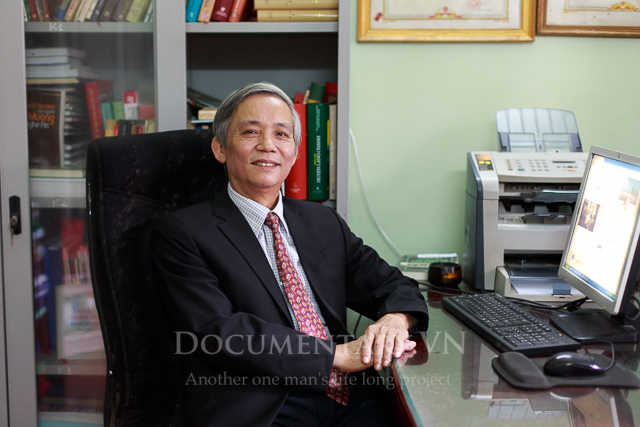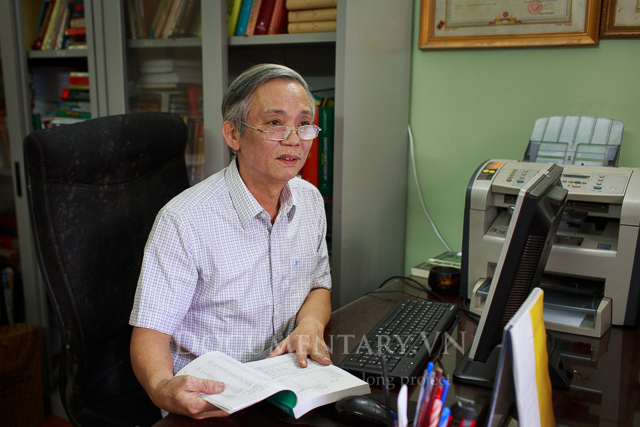
Lam Ba Nam was born in Vien Trung village, Hai An commune, Tinh Gia district, Thanh Hoa province. His childhood years coincided with the war, when the land, still heavily bombed by the Lao wind, was a wasteland. The children of the village grew up attending night classes, their pockets filled with a few pieces of sweet potato or ginger, their straw hats and oil lamps rustling as they silently walked past the jagged bomb craters. Simply being able to attend school was considered a success. Reaching high school was rare; only two or three students from the entire village did so each year. University was a rarity, perhaps only one every few years.
In 1973, Lam Ba Nam entered university.
In the spring of 1975, he was a second-year student in the History Department at Hanoi University. But that was also the time when tanks and the red flag with a yellow star led the entire nation to the South like a storm. More than 100,000 reserve troops were mobilized for the front lines. He temporarily left school to take up arms. He was twenty years old at the time.

Associate Professor, Doctor, Distinguished Teacher Lam Ba Nam is the Head of the Anthropology Department (2010-2014); Vice Rector of the University of Social Sciences and Humanities (2006-2009); President of the Vietnam Ethnology and Anthropology Association (2013 to present)/Photo: Thanh Long
His military service took him through nearly six years of his twenties, from the scorching sun of Son Tay to the biting cold of standing guard at night amidst the deafening artillery fire of the border war. But those six years did not diminish his yearning to return to the lecture hall. In 1980, he was discharged from the army and returned to student life for the second time to complete the remaining half of his unfinished university studies, before being retained as a lecturer in the History Department two years later. And from there, he began a new journey, that of a teacher and an ethnologist.
In the eyes of his friends, colleagues, and students, Lam Ba Nam was first and foremost a teacher. Throughout his forty years of teaching, from his time in the military as a cultural teacher at the Air Force Training School (1975) to his current position as a lecturer at Hanoi University and the University of Social Sciences and Humanities, he taught countless generations of students. Those who were taught by him were impressed by a kind and strict, calm and passionate teacher. Teacher Lam Ba Nam had graying hair, a deep, resonant voice, and his lectures flowed effortlessly in the lecture hall, often with sweat dripping from his lips, as if pouring his heart and soul into his speech.
But he is remembered and admired primarily as an ethnologist. Belonging to the third generation of ethnologists in Vietnam, he both inherited the research achievements of his predecessors and explored new issues, thereby gradually affirming his unique contributions to ethnological knowledge and research.
His connection with Muong culture began very early. After graduating from university, he was assigned by his department to research ethnic groups belonging to the Viet-Muong language family. Through Mr. Nguyen Quoc Tuan (currently the Director of the Institute of Religious Studies, Vietnam Academy of Social Sciences), he met Professor Nguyen Duc Tu Chi, whom he always considered a great mentor in his teaching and research career. During a drinking session at his home, Professor Tu Chi advised him that if he wanted to study the Vietnamese people, he should first study the Muong people or another minority ethnic group belonging to this language family, and then approach comparative research from there. Following this advice, he traveled to many Muong regions, from Hoa Binh and Thanh Hoa to Phu Tho, to rediscover traces of ancient Vietnamese civilization through rituals, especially agricultural rituals, as well as the Viet-Muong relationship through the image of Tan Vien, one of the "four immortals" of the Vietnamese people but still intact in the folk consciousness of the Muong people. In that early stage of his career, he became a valuable collaborator with the Department of Culture and Information of Ha Son Binh (later Ha Tay) with articles in the late 1980s such as:The Muong Thinh Lang people's rice field ritual;Some thoughts about the Muong Lac Thuy land.;A few words about the Đoài region...was praised by Professor Tran Quoc Vuong. He recounted humorously that one time, while he and his colleagues were discussing something in the hallway of the History Department (3rd floor, building B), they met Professor Tran Quoc Vuong. Suddenly, the professor asked: "Hey, ethnologists, where are the origins of the ancient Vietnamese?" Without hesitation, he replied: "Sir, at the foot of Ba Vi mountain." Professor Vuong praised him: "This fellow is brilliant!" This very fact motivated him to continue his search for the origins of the nation's civilization.
On his scientific journey, starting in the mid-1980s, he began researching traditional craft villages and their heritage, primarily those of the Vietnamese people. This stemmed from initial premonitions he had while reading.The origins of the family, private property, and the state.Regarding Engels' famous views on the great social division of labor, he visited many craft villages in Hanoi, Ha Tay, Nam Dinh, Thai Binh, Hai Duong, and Thanh Hoa to compare and arrive at a key conclusion: unlike the Western context in Engels' research, the unclear division of labor, especially the mix between agriculture and handicrafts, is a prominent characteristic in Vietnam, existing from the very beginning of national civilization and even remaining strong today. He affirmed this view in several studies published in specialized journals, international conferences, and especially in monographs.Traditional weaving in the Northern Delta of VietnamPublished in 1999.

Associate Professor, Doctor, Meritorious Teacher Lam Ba Nam has dedicated over 30 years to the field of Anthropology/Photo: Thanh Long
For over 30 years, as a lecturer, Head of Department, and President of the Vietnam Association of Ethnology and Anthropology, he has devoted special attention to research on the community culture of ethnic groups in our country and ethnic policies. As early as 1990, he and Le Ngoc Thang compiled the book...Cultural identity of the ethnic groups of VietnamHis aim was to introduce the culture of each ethnic group. Over the past three decades, he has continued to devote his attention and reflection to the issues of culture and cultural preservation, culture and development, and culture and ethnic equality. On his ethnographic journey, he has traveled throughout the country, from the Dong Van Karst Plateau to the Truong Son Mountains and the Central Highlands, from the Northern and Central plains to the Southern plains. From a very early age, he recognized the dynamics of ethnic cultures and the crucial role of culture in the lives of all ethnic groups. He has had many opportunities to present the cultures of Vietnamese ethnic communities at international forums and conferences in Tanzania, China, and Japan. Among his 130 works, including books and articles, approximately 40 address the cultures of various ethnic groups, from the Kinh, Muong, Chut, Tay, Nung, Thai, Ede, Ba Na, Cham, and Khmer. Beyond basic research, he and his colleagues have participated in studying the impact of culture on development projects such as: the Chan May deep-water port construction project in Thua Thien Hue; the Dung Quat oil refinery industrial park construction project; the agricultural diversification project in the Truong Son-Central Highlands region; the Hoa Binh hydroelectric power plant construction project; and UNICEF's action-oriented project to support women and children of ethnic minorities in Vietnam. Through these efforts, he has contributed to making cultural issues a fundamental part of the planning process for key national development projects during the industrialization period.
Among his published works, he was particularly interested in the issue of ethnicity and ethnic policies in Vietnam. In addition to his work on historical ethnic policies, he also addressed this topic.Ethnic policies of the feudal states of Vietnam(National Political Publishing House 2001, co-authored with Professor Phan Huu Dat), he participated in compiling lectures for study in universities and military schools; researched and proposed policies related to cultural preservation, culture and tourism, the specific characteristics of ethnic minorities, particularly disadvantaged ethnic groups, and the principles of the Party and State's ethnic policy; and suggested that the Party should summarize 70 years of ethnic policy in light of the country's new development requirements.
The success in training and developing the field of Anthropology in Vietnam in general and at the University in particular over the past ten years acknowledges his important and positive contributions. In leadership positions at the Department, University, and Association levels, he has promoted and worked with colleagues to overcome many difficulties in completing the development of the University's Anthropology training programs and the Ministry of Education and Training's Anthropology framework program, as well as establishing the Department of Anthropology within the Faculty of History, the Department of Anthropology within the University, and preparing for the establishment of the Faculty of Anthropology at the University of Social Sciences and Humanities.
|
Associate Professor, Doctor, Distinguished Teacher Lam Ba Nam
+ Workplace: Department of History. Department of Anthropology. + Management position: Head of the Department of Ethnology/Anthropology, Faculty of History (2000-2007). Head of the Department of Anthropology, University of Social Sciences and Humanities (2010-2014). Vice Rector of the University of Social Sciences and Humanities (2006-2009). President of the Vietnam Association of Ethnology and Anthropology (2013 to present).
Cultural identity of the ethnic groups of Vietnam(co-authored with Le Ngoc Thang) National Culture Publishing House, Hanoi 1990. Traditional weaving in the Northern Delta of Vietnam. Social Sciences Publishing House, Hanoi 1999. Ethnic policies of the feudal states of Vietnam(co-authored with Phan Hữu Dật). National Political Publishing House, Hanoi 2001. Hoa Binh Hydroelectric Power Plant: A Project of the Century(Editor-in-chief). Labor Publishing House, 2006. |
Author:Ha Thu